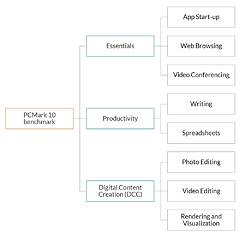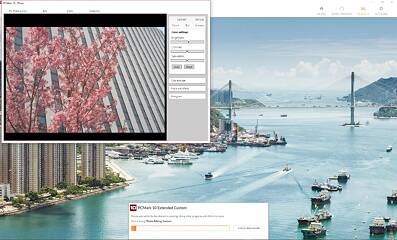 22
22
Futuremark PCMark 10 Review
PCMark 10 Extended »PCMark 10
PCMark 10 is the only benchmark that will be available in the free Basic Edition, and thus, it will be the most important one to readers today. We see that it expands on the PCMark 10 Express benchmark by adding a third test group on digital content creation (DCC), which is definitely very appropriate to a good number of enthusiasts today. The Essentials and Productivity groups remain the same, so we will not cover them again here. As before, the background in the screenshots below are from PCMark 10 Extended, but that is the only difference from when these are run as part of the PCMark 10 benchmark.
Photo Editing
GIMP is the application of choice here, and I will admit to not having used it as often as I should. It is an extremely flexible program for photo editing, and I am glad to see it getting more coverage. The photo editing test involves an interactive scenario and a batch scenario. The former loads a reference image and applies some commonly used edits via sliders - brightness, contrast, unsharp mask, saturation, wavelet denoise, save as JPG, save as PNG, etc. The batch scenario loads multiple thumbnail images into a preview matrix and applies some batch edits to all of them. The test score is as always quantified in terms of time taken.
Video Editing
This test uses a lot of the same subroutines as PCMark 8's Video Editing and Media To Go tests. Similar to the video conference test in the productivity group, Windows Media Foundation is used in OpenCL mode. You will not actually see something running here, which is unlike previous tests, but a score is generated from processes ongoing in the test engine. The test loads a source H.264 1080p video and applies some commonly used edits, including sharpening and deshaking. You do need a compatible CPU for this test. While not something I do personally, I do enjoy the fruits of a video editor's labors when watching videos online, and I am thus confident this will remain an extremely valid test.Rendering and Visualization
This test caters to professionals and hobbyists alike who have their time consumed by 3D design, modeling, simulations, and, as the test suggests, visualization. There are two scenarios here - a 3D model visualization and a simulation. The build engine of Futuremark's own 3DMark Sling Shot is used, but involves ray tracing using the POV-RAY benchmark.
The eight test routines in the three test groups have an individual score each, and the test group scores are calculated as described in the technical guide. The PCMark 10 score is thus calculated as: Score = K * geomean (Se,Sp,Sd) where K= 0.717 (which scales the score to 5000 on the reference PC); Se = Essentials group score; Sp = Productivity group score; Sd = DCC group score.
Apr 3rd, 2025 04:48 EDT
change timezone
Latest GPU Drivers
New Forum Posts
- Since all gpu's models perform the same, why review dozen of different models? (11)
- RX 9000 series GPU Owners Club (120)
- Help with System Recommendations (9)
- A slightly strange problem with a GPU (11)
- NZXT N9 X870E is out (despite their website still saying: coming soon) (9)
- Mllse 6600s that are locked at 500 mhz. (1)
- Is RX 9070 VRAM temperature regular value or hotspot? (298)
- TechPowerUp Screenshot Thread (MASSIVE 56K WARNING) (4266)
- Windows 11 General Discussion (5917)
- Montech KING 95 - your opinions? (14)
Popular Reviews
- DDR5 CUDIMM Explained & Benched - The New Memory Standard
- Sapphire Radeon RX 9070 XT Pulse Review
- SilverStone Lucid 04 Review
- PowerColor Radeon RX 9070 Hellhound Review
- Sapphire Radeon RX 9070 XT Nitro+ Review - Beating NVIDIA
- ASRock Phantom Gaming B850 Riptide Wi-Fi Review - Amazing Price/Performance
- Palit GeForce RTX 5070 GamingPro OC Review
- Pwnage Trinity CF Review
- AMD Ryzen 7 9800X3D Review - The Best Gaming Processor
- Samsung 9100 Pro 2 TB Review - The Best Gen 5 SSD
Controversial News Posts
- MSI Doesn't Plan Radeon RX 9000 Series GPUs, Skips AMD RDNA 4 Generation Entirely (146)
- Microsoft Introduces Copilot for Gaming (124)
- AMD Radeon RX 9070 XT Reportedly Outperforms RTX 5080 Through Undervolting (119)
- NVIDIA Reportedly Prepares GeForce RTX 5060 and RTX 5060 Ti Unveil Tomorrow (115)
- Over 200,000 Sold Radeon RX 9070 and RX 9070 XT GPUs? AMD Says No Number was Given (100)
- NVIDIA GeForce RTX 5050, RTX 5060, and RTX 5060 Ti Specifications Leak (96)
- Retailers Anticipate Increased Radeon RX 9070 Series Prices, After Initial Shipments of "MSRP" Models (90)
- China Develops Domestic EUV Tool, ASML Monopoly in Trouble (88)


